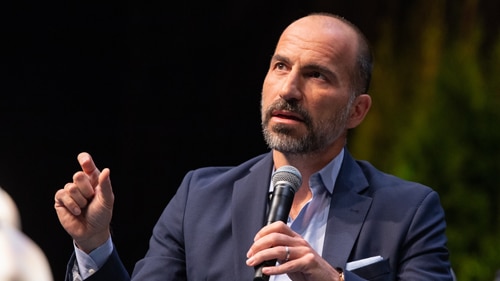Uber’s CEO knows better than most the necessity of a values-driven corporate culture. Dara Khosrowshahi has been the CEO of Uber since September 2017, when he left his position as CEO at Expedia to lead a new breed of company. Uber is arguably one of Silicon Valley’s best examples of how cutting-edge technology combined with customer obsession can fundamentally change industries, business models, and customer expectations.
 Since its launch in 2011, Uber has grown rapidly — scratching some paintwork along the way — to become the single largest urban transport technology company in the world, operating in over 70 countries, with net revenues of $2.7 billion in the second quarter of 2018.
Since its launch in 2011, Uber has grown rapidly — scratching some paintwork along the way — to become the single largest urban transport technology company in the world, operating in over 70 countries, with net revenues of $2.7 billion in the second quarter of 2018.
Salesforce sat down with Khosrowshahi to discuss the future of Uber, the future of transportation, and why a strong values-driven culture is so crucial to long-term business success.
Q: As the Fourth Industrial Revolution ushers in a period of unprecedented and rapid change to every area of business, leaders must tap every opportunity to build a more agile, innovative workforce. How does an outstanding culture help companies deal with the disruption of the Fourth Industrial Revolution, and what cultural characteristics do the most innovative companies share?
The most innovative companies are ones that aren’t afraid to disrupt themselves. What I mean by that is companies that aren’t afraid to build products that might cannibalize resources, take away customers from one part of the business, or cost more in the short term — if there’s a clear long-term need and business opportunity.
Take Amazon, for example. They started out by selling paperback and hardcover books. A few years later, they revolutionized the e-book, which inevitably moved people away from buying physical books. If you don’t disrupt yourself, someone else will come along and do it anyways.
It’s also equally important that when you’re innovating, you stay customer-obsessed and do the right thing from day one. It’s the only way to ensure long-term success backed by a strong brand.

Q: Research from Salesforce shows that 80% of business professionals believe businesses have a responsibility to look beyond profit and make a positive impact on society. A separate study reveals that 56% of millennials have ruled out ever working for a particular organization because their values didn’t align. As the so-called war for talent gathers steam in the Fourth Industrial Revolution, how can companies build a culture that competes?
It’s super important to have a set of cultural values from the beginning that are living and breathing things, and that serve as a North Star for every decision your teams make and, more importantly, how you get to that decision. That doesn’t mean values can’t change or adapt as you evolve as a company — they absolutely do and they should. As a leader, I feel strongly that culture needs to be written from the bottom up. A culture that’s pushed from the top down doesn’t work, because people don’t believe in it. At Uber, we crowdsourced our cultural norms from employees.
And we fully expect these norms to change over time; Uber has always been a company that embraces change, and we’re approaching our culture in the same way. We certainly don’t expect our norms to change overnight — or every year — but we always want to take stock of who we are, who we want to be, and move accordingly.

Q: The Fourth Industrial Revolution also promises a revolution in mobility, with self-driving cars being the most obvious manifestation of that. What will this future look like, how will this mobility revolution impact society, and what is Uber’s plan to enable that future?
There’s a lot of enthusiasm about how new technology like autonomous and electric vehicles can make transportation safer, more affordable, and more sustainable. But to get there, the single most important thing we have to get right is making transportation shared.
Right now, in countries like the U.S., the overwhelming majority of travel is completed using cars that are individually owned and operated. As a result, cars typically only move one person at a time, and they spend the vast majority of their life parked. Parking consumes enormous amounts of land, making cities more expensive and less pedestrian-friendly.
Today, technology like ridesharing — and ultimately self-driving vehicles in the future — gives us a unique chance to turn the individual car ownership model on its head, opening up enormous social benefits. But we need to make the experience of relying on shared transportation — not just in cars, but also in new options like electric bikes and scooters — more convenient than owning a car. That’s the challenge we think that Uber, as the single largest urban transport technology company in the world, is uniquely qualified to help solve.

Q: As customer expectations continue to grow, so does the expectation for personalization by businesses and services. One of the themes we’ve heard this year is how to use “high tech to enable high-touch experiences.” Uber has obviously used high tech to create an incredible service and disrupt an industry, but how are you looking at technology to deliver the personalized experience that your passengers want?
We have focused a lot of our effort on making the Uber app a one-stop resource for people’s needs as they move around their cities. My top priority for this year has been safety, so I have focused a lot of time on looking for ways we can leverage our tech to make Uber a safer platform.
Earlier this year, we introduced a series of safety improvements including a new emergency button in our app that connects riders directly with 911. We’ve also built tools to allow riders to designate up to five friends or family members as “trusted contacts,” so they can more easily share their trips with them on every ride. And we recently announced Ride Check, which uses GPS to allow Uber to proactively reach our customers if we detect a crash or an unexpected situation, like an unusually long stop.
I’ve also been focused on how we can make Uber a platform for multi-modal transportation around cities. We are always looking to offer more ways to get around without needing to own a car. We’ve now integrated our JUMP e-bikes into the Uber app, allowing people to switch easily between different modes of transportation. And by adding bikes to more cities on a regular basis, we hope more of our riders get out of cars when they aren’t the best way to get around (like short trips during rush hour) and onto bikes. We believe that’s a win for our customers, for Uber, and for the cities we serve.
This article is part of a series of interviews with business leaders on navigating the Fourth Industrial Revolution. Other interviews in the series include Steve Nelson, CEO of UnitedHealthcare, Bernard Tyson, CEO of Kaiser Permanente, and Kai-Fu Lee, CEO of Sinovation Ventures.


















![[Illustration] A service rep delivers proactive customer service](https://www.salesforce.com/blog/wp-content/uploads/sites/2/2024/11/proactive-customer-service-1500x844_60k.jpg?w=128&h=96&crop=1&quality=75)










